| by Dirk Dusharme
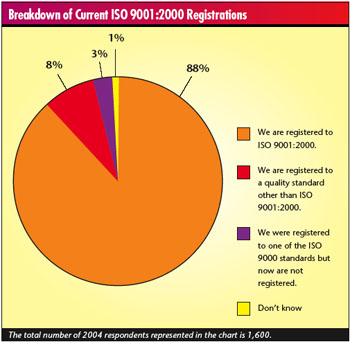 Monday, Dec. 15 came and went. So much
for Black Tuesday. The sky didn’t fall. Armageddon
didn’t commence.
Hundreds of ISO 9000 coordinators and managers didn’t
throw themselves off towers of manuals, procedures and
ISO 9001:2000 interpretations (although more than a few
auditors were on the verge), and Santa Claus, once again,
picked cookies off the fireplace and left shiny registration
certificates in their place. All is well; all is right. Monday, Dec. 15 came and went. So much
for Black Tuesday. The sky didn’t fall. Armageddon
didn’t commence.
Hundreds of ISO 9000 coordinators and managers didn’t
throw themselves off towers of manuals, procedures and
ISO 9001:2000 interpretations (although more than a few
auditors were on the verge), and Santa Claus, once again,
picked cookies off the fireplace and left shiny registration
certificates in their place. All is well; all is right.
We hate to admit it, but all of us prognosticators of
doom were wrong. Somehow, almost all ISO 9000-registered
companies--about 95 percent--made the transition deadline.
So, with the anticipated 120-point headline now up in
flames (“Transition Deadline Takes Deadly Toll”)
and our scorched earth, post-nuclear holocaust cover design
in the trash, what is there to write about?
This, our final ISO 9001:2000 transition survey, was
conducted immediately following the Dec. 15 transition
deadline. Despite the closeness to the holidays, we received
a respectable number of responses to the 30,988 fax invitations
to the survey--1,600 responses exactly--or a response rate
of more than 5 percent.
We also sent a questionnaire to all registrars to see
if their figures would correspond with survey results.
Of 76 registrars contacted, 15 responded.
The survey shows that 87 percent of all U.S. and Canadian
companies registered to an ISO 9000 or related standard
are now registered to ISO 9001:2000, with another 8 percent
now being registered to a different standard. So, roughly
95 percent of all companies contacted are registered to
some quality management system standard. In our last survey,
conducted in July 2003 and presented in the August issue,
this group comprised about 56 percent. That means the remaining
39 percent of registrations, between 20,000 and 25,000
certificates, were completed
within the last six months. It’s no wonder that the
registrars we tried to contact for this story were either
unavailable or downright grumpy--the volume of work was
pushing the registrars and their auditors to the limits.
A little more than 3 percent of survey respondents reported
that they didn’t make the deadline. This corresponds
pretty closely to the numbers supplied to us by the registrars.
In total, these registrars, which represent more than 25
percent of all registrations in the United States and Canada,
claim that just fewer than 7 percent of their clients didn’t
make the transition.
It’s no surprise that the primary reason given
for missing the deadline is that the companies simply ran
out of time. Of those companies that lost their registration
(which excludes companies that are going to another standard,
such as ISO/TS 16949), 47 percent reported that they ran
out of time. Other reasons were spread fairly evenly: too
expensive, no perceived value, plant closures, no customer
mandate and so forth.
Interestingly, although lack of time was the key issue,
most respondents blame their companies and not the International
Organization for Standardization’s deadline for missing
the transition date. Responding to the statement, “There
was insufficient time allotted by ISO to make the transition,” responses
were evenly distributed among disagreeing (34%), agreeing
(30%) and neutral (31%). On the other hand, in response
to the statement, “There was insufficient time allotted
by my company to make the transition,” the majority
of respondents (54%) agreed, and just one-fourth (25%)
disagreed.
Companies didn’t seem to blame their registrars
for missing the boat either. Nearly 45 percent of those
that missed transition felt their registrars had been proactive
in helping them make the transition. Only 17 percent felt
their registrars weren’t proactive enough, and 38
percent were neutral.
That said, the percentages from the 2004 survey were
much tamer than those from the August survey, in which
respondents more strongly disagreed with both of the statements
(a difference of about 20 percentage points, as illustrated
in the chart below). This could be reflective of a “no
problem; we’ve got plenty of time” attitude
that may have existed five months before the deadline.
Having missed the deadline, respondents may now be more
critical of it.
But just because these companies didn’t make the
transition doesn’t mean they’re bowing out.
More than 69 percent of those that didn’t make transition
say that they still plan to get registered, 16 percent
say they won’t and 16 percent aren’t sure.
Regardless of whether they eventually register, within
that same group, 93 percent say they plan to maintain compliance
with either the 1994 or 2000 version of the standard.
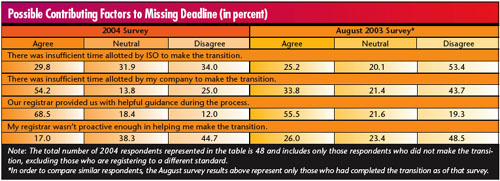
By far, the most prevalent standards to which companies
were registered other than ISO 9001:2000 were ISO/TS 16949
and QS-9000. Of those companies registering to another
standard, 39 percent reported they’re registering
to ISO/TS 16949 and 26 percent with QS-9000.
For those planning to register to ISO/TS 16949, there
was no need to become registered to ISO 9001:2000 because
the new automotive standard already includes all of ISO
9001:2000. However, the Big Three’s mandated deadline
for becoming registered to ISO/TS 16949 is as far away
as 2006, providing extra time for companies to get their
quality management system into shape. For organizations
that are already registered to QS-9000, their ISO 9001:1994
registration remains valid until they transition to ISO/TS
16949.
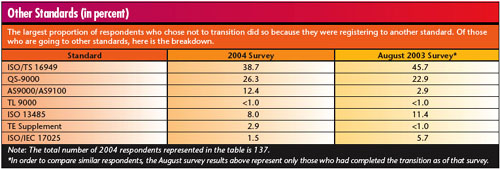
As with last August’s survey, the overall value
of ISO 9001:2000 registration is perceived to be very high,
with 79 percent of respondents agreeing with the statement, “Overall,
I found the process to be beneficial to our organization.” This
is the same percentage we got last year for the same question.
Registration’s effect on products and services
or on a company’s internal processes was also favorable
and similar to last August’s survey. In this survey,
46 percent of respondents agreed that products or services
had improved as a result of registration, and 21 percent
disagreed. More than 73 percent agreed that their organizations
function better as a result of registration; 12 percent
disagreed.
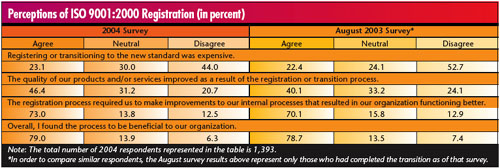
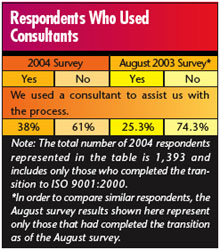 Given
the fact that registrars had been slammed with a tremendous
amount of work to get every organization registered
before the deadline, we were somewhat surprised that the
registrars got a high score for helpfulness, only a bit
lower than the last survey. In response to the statement, “Our
registrar provided us with helpful guidance during the
registration process,” 68 percent of respondents
agreed with the statement compared to 71 percent in August.
We would have expected customer service to fall off considerably
during this hectic period, but it only showed a slight
decrease. Given
the fact that registrars had been slammed with a tremendous
amount of work to get every organization registered
before the deadline, we were somewhat surprised that the
registrars got a high score for helpfulness, only a bit
lower than the last survey. In response to the statement, “Our
registrar provided us with helpful guidance during the
registration process,” 68 percent of respondents
agreed with the statement compared to 71 percent in August.
We would have expected customer service to fall off considerably
during this hectic period, but it only showed a slight
decrease.
In terms of the ISO 9001:2000 transition, it appears
that consultants didn’t pick up much work. Only 38
percent of registered companies report having used a consultant.
The most probable reason for this is that companies that
were transitioning already had experience with the registration
process and felt capable of doing it on their own. Although
we didn’t ask the question, we wouldn’t be
surprised if the majority of those that did use a consultant
were registering to a quality management system standard
for the first time.
This year’s survey was faxed to 38,090 U.S. and
Canadian numbers pulled from the Quality Digest’s
Online Database of North American Registered Companies,
a subscription to which is available at www.qualitydigest.com/iso9000database.shtml.
Of those, 30,988 faxes were successfully sent. Of those,
1,600 online surveys
were completed, a response rate of 5.2 percent.
For the first time, the survey was also presented in
French, allowing us to include responses from predominantly
French-speaking companies, in particular, those located
in Quebec. Translation was provided by Daniel Désilets
from the Canadian headquarters of registrar Intertek Systems
Certification.
The online survey was designed using SurveyGold from
Golden Hills Software Inc. Responses were collected by
Golden Hills Software and downloaded to Quality Digest
at the survey’s conclusion.
Data analysis was done by Quality Digest. The choice
of data to extract was based on conversations with registrars
and our knowledge of topics that interest our readers.
Dirk Dusharme is Quality Digest’s technology
editor.
|